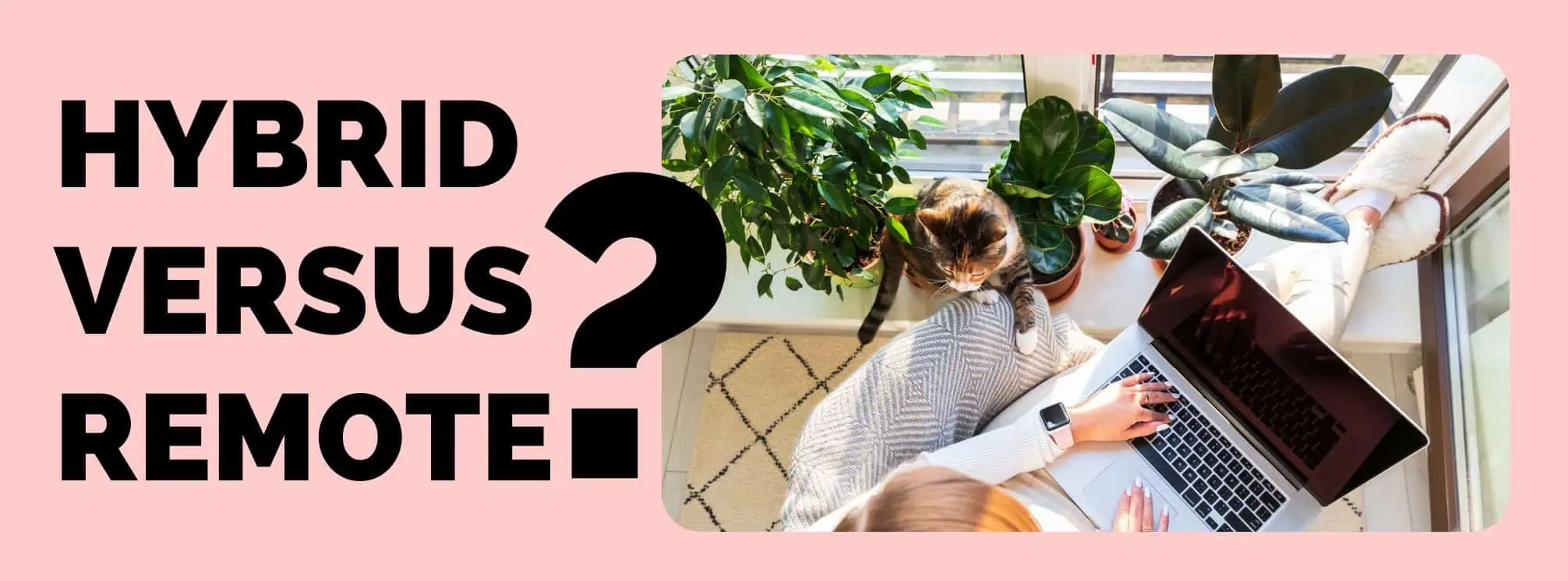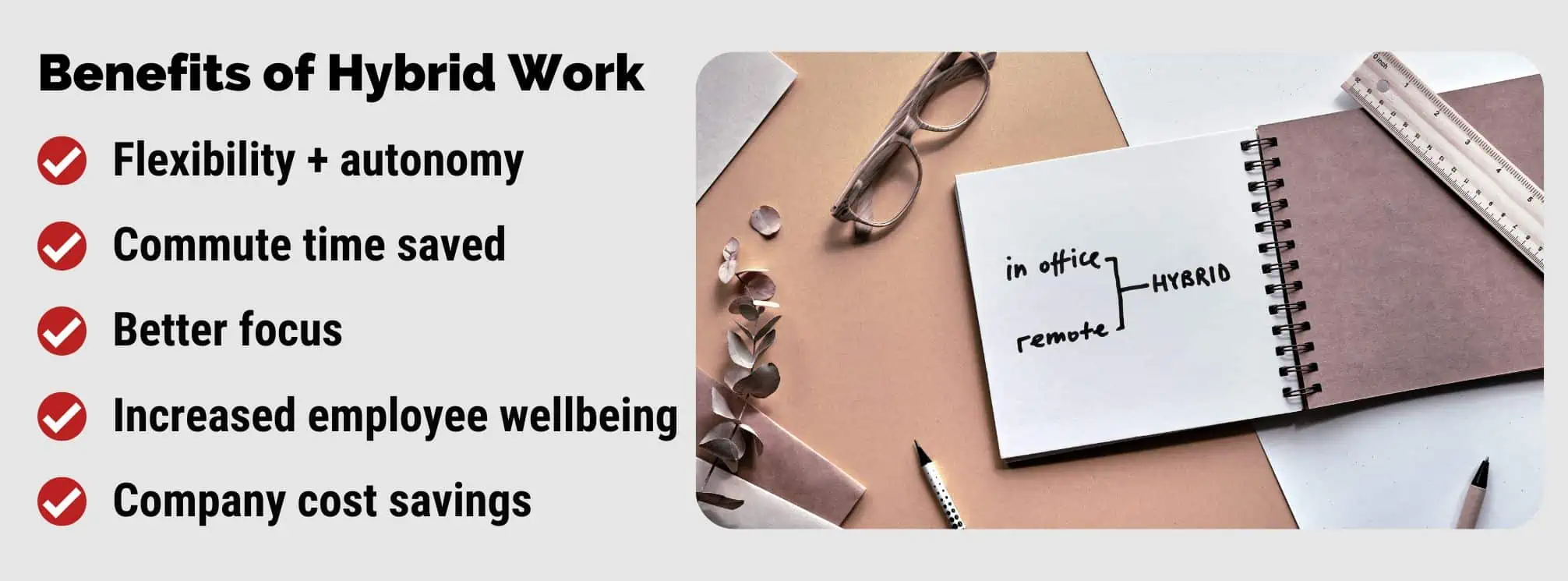The Hybrid Workforce: Everything to Know About Hybrid Work
The hybrid workforce is taking the world of work by storm. Because of the benefits of in-person collaboration, hybrid work models might soon become the most common work arrangement for computer workers. Are you prepared to support a distributed workforce? Read our comprehensive guide to find out.
What is the Hybrid Workforce?
The hybrid workforce refers to a work arrangement where employees have the flexibility to work both remotely and from a physical office location. It combines elements of remote work and traditional in-person work, taking advantage of the perks of both work locations.
In a hybrid workforce model, employees may work remotely for certain days or specific hours and come into the office for team meetings, collaborative work, or other activities that require in-person interaction.
The hybrid workforce model has gained significant popularity, particularly after the COVID-19 pandemic, as it offers a balance between the benefits of remote work and the advantages of in-person collaboration. It provides employees with greater flexibility, reduces commuting time and costs, promotes work-life balance, and allows for better integration of personal and professional responsibilities.
To successfully implement a hybrid workforce, companies need to establish clear policies and guidelines, leverage appropriate technology tools for collaboration, and foster a supportive work environment that values both remote and in-person contributions. Effective communication and seamless coordination between remote and on-site team members are key to maximizing the benefits of this work model.

Examples of How Hybrid Work is Applied
There are a few ways companies implement a hybrid workforce model:
- Choosing set days that everyone comes into the office versus working from home.
- Setting the number of days that employees must come to the office but letting employees choose which days they come into the office.
- Letting employees have full autonomy over how many days they come into the office.
What is the Difference Between Hybrid vs. Remote Workers?
The main difference between hybrid workers and remote workers is the percent of time they spend working from home.
Hybrid workers have a work arrangement that combines both remote work and in-person work at a physical office location. They enjoy some more flexibility than office staff but can also benefit from in-person collaboration and camaraderie.
Whereas remote employees work completely outside of the traditional office setting. These employees may choose to work from home, a co-working space, or other remote settings.
The Benefits of Having a Hybrid Workforce
There are many benefits of embracing a hybrid work model, both for employees and for your organization.
Benefits of Hybrid Working for Employees
- Flexibility. Hybrid work models provide employees with more flexibility, which allows them to create a work environment that suits their preferences and needs. This also offers more equity for employees with children, disabilities, caregiving responsibilities, and so on.
- No commute. Hybrid employees can save time and money by avoiding long commutes to the office. They can use this saved time for personal activities or to engage in professional development. Additionally, reduced commuting can lead to cost savings on transportation, parking, and other related expenses.
- Increased autonomy. Hybrid work empowers employees with greater autonomy in managing their work schedule and environment. They have more control over when and where they work, which can boost their productivity and job satisfaction.
- Improved focus and productivity. Some employees find that working in a quieter and less distracting environment, such as their home, enhances their focus and productivity.
- Better work-life balance. Hybrid work models promote a healthier work-life balance by providing employees with the flexibility to accommodate personal commitments, such as family responsibilities, appointments, or personal interests. This balance can contribute to reduced stress and increased overall well-being.
Benefits of Hybrid Working for Companies
- Talent acquisition and retention. Offering hybrid work options can be a competitive advantage in attracting and retaining top talent. Many job seekers value the flexibility and work-life balance that hybrid models provide, making a company more appealing as an employer.
- Increased employee satisfaction. Hybrid work models tend to improve employee satisfaction and engagement. When employees have more control over their work environment and schedule, they are likely to be more motivated, committed, and invested in their work.
- Cost savings. Hybrid work models can lead to cost savings for companies. With a reduced number of employees working in the office at any given time, companies can optimize their office space, reducing real estate and related expenses. Additionally, employees covering some of their work-related costs, such as utilities or office supplies, can contribute to cost savings.
The Disadvantages of Hybrid Work
While hybrid work models come with several benefits, there are also potential disadvantages to look out for:
- Inequality and division. Hybrid work arrangements can lead to a sense of inequality or division among employees. Those who work remotely may feel disconnected from in-office activities, miss out on face-to-face interactions, or experience a perceived lack of visibility and opportunities for career advancement.
- Blurred boundaries between work and personal life. Hybrid work can blur the boundaries between work and personal life, especially when employees work from home. Without clear separation, it becomes challenging to maintain work-life balance and prevent work from encroaching on personal time, leading to potential burnout and reduced well-being.
- Potential decrease in team cohesion. Hybrid work arrangements may impact team cohesion and camaraderie. When team members have limited face-to-face interactions, it can be more challenging to build strong relationships, trust, and a shared sense of purpose. This can affect collaboration, teamwork, and overall team dynamics.
It’s important to note that these disadvantages can vary depending on your business, the nature of your work, and how effectively the challenges are addressed through proper communication, supportive policies, and a well-designed hybrid workforce strategy.
Challenges of Communicating With Hybrid Workers
When managing a hybrid workforce, communication can become more complex due to the mix of in-person and remote employees. Here are five specific challenges you may face when communicating with your hybrid workforce:
- Communication gaps. Communication gaps can occur between in-person and remote employees. In-person discussions and impromptu interactions may exclude remote workers, making it essential to find effective ways to keep everyone informed and included. It’s important to document as much as you can to make up for these gaps.
- Technology constraints. If you don’t have the right tech stack for your employees while they’re working from home, you might be limiting their potential. Not investing in the right technology also sends a message that you aren’t really willing to support remote employees.
- Building trust and connection. Relating to employees and building rapport is more challenging without face-to-face interactions. Executives and managers should consider more video updates to their teams to make up for the distance.
To overcome these challenges, you should implement strategies such as:
- Using inclusive communication tools
- Establishing regular check-ins
- Providing clear and consistent information across a variety of channels
- Encouraging open and transparent communication
[optin-monster slug=”hjjlevubfvt2q3mkvza4″ followrules=”true”]
Company Communication Solutions for the Hybrid Workforce
You’ll need a diverse channel mix to adequately reach your employees both at home and at the office. That’s why it’s so important to assess your current workflows, culture, and technology to learn where there are any gaps. We recommend trying an internal comms audit during this process!
From there, you’ll need to make sure you address all elements of communication:
- Top-down communication, which includes company updates, executive communications, company events, etc. For this type of information sharing, you’ll need broadcast channels like an intranet, app, email, and/or texting.
- Peer-to-peer collaboration platforms like Slack and Google Docs to enable cloud-based collaboration.
- Resource hubs and portals so employees can access any document or tool from any work location.
Interested in learning how theEMPLOYEEapp can become your primary broadcast channel and resource center? Request a demo today.
[optin-monster slug=”ucyxtz2fxemh6aryl4gg” followrules=”true”]



